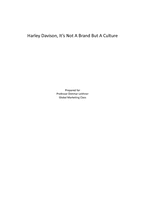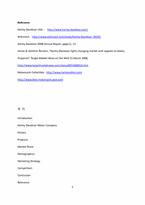Harley Davidson Motor Company
History
Products
Market Share
Demographics
Marketing Strategy
Competitors
Conclusion
Reference
The average age of the current Harley customer is approx. 55 years old, and they are now starting to face physical challenges and financial troubles from the recent credit crisis that might keep them off of their Hogs for good. Furthermore, only 12% of their customer base is female. Ethnic groups are also a weak demographic for Harley. Meanwhile, Harley has not been able to attract Gen X/Y'ers (25-34 yr olds) to replace the aging baby boomer population. Competitors Suzuki, Honda, Yamaha, and Kawasaki have a combined 92% of the Gen X/Y market.
Marketing Strategy
Harley-Davidson was reincorporated in 1981 after it was purchased by 13 of its managers through a leveraged buyout (LBO). The management team realized that the company would need to be rebuilt from the ground up to survive. The company’s market share in the United States had fallen to 3 percent, primarily because its products were unreliable and had poorer performance relative to less expensive Japanese motorcycles. In addition, its network of dealers ran greasy, run-down shops that many people didn’t feel comfortable visiting. Upon assessing the company’s situation, the management team concluded that a strong allegiance to the Harley brand by many bikers was the company’s only resource strength. However, when management began to meet with customers, they found that long time Harley were angry about the lack of attention to product quality and customer service under AMF ownership. After the LBO, Harley management tried to win over previous customers by attending any function at which motorcyclists congregated. The situation changed when Harley owners saw their suggestions being implemented by the company.
Harley-Davidson’s turnaround strategy including improving product quality by adopting Japanese management practices, abandoning a reliance on advertising in favor of promotions at motorcycle rallies, and improving its dealer network to broaden its appeal to new customers. After hearing complaints about dealers from Harley riders at rallies and other bike events, Harley-Davidson conducted a pilot program with two dealers in Milwaukee that called for the dealers to build clean, attractive stores to showcase Harley’s improved motorcycles and display apparel and other merchandise that cyclists might wish to purchase. The pilot program led to new or remodeled dealerships across the Harley-Davidson network and helped the company enter into a new product category. Harley showrooms offered a large assortment of clothing items and such accessories as helmets, boots, leather jackets, and T-shirts in addition to new motorcycles.
After Harley-Davidson’s product quality issues had been resolved, the company focused on cultivating the mystique of Harley ownership. The company formed Harley Owners Groups (HOGs) in 1983 to provide Harley owners with local clubs where they could socialize and ride with other owners. Harley-Davidson established HOGs in cities where dealers were located but did not interfere with HOGs’ operations or try to use the organization in a self-serving way. The company’s primary interest in setting up the chapters was to give motorcycle buyers a sense of community. Management understood that once new owners came to feel they belonged to the Harley community, they would bring new buyers to the company without any encouragement from Harley-Davidson.
Competitors
In comparison to the Harley Davidson’s biggest rivals, the Japanese big 4, Harley Davidson has always been focusing on the sensitivity of their customers in the South Korean market and also throughout the world, which is called the culture marketing. For example, when advertising in the magazines, Harley Davidson is very famous for making famous copies that move people’s hearts. On the other side, Japanese rivals were busy just to show off their motorcycles’ pictures or specifications which were pretty much the same. Furthermore, for customers who were not interested in motorcycles couldn’t even recognize the difference between a Honda’s advertisements and Yamaha’s. Like this, when their rivals were showing off latest technology and relevantly cheap prices, Harley Davidson focused on high price, low quality. This could sound strange. However, this is possible for Harley Davidson because they have a great number of loyal fans who know that Harley Davidson is the only manufacturer in the world that can make an OHV engine lik
Wikinvest. - http://www.wikinvest.com/stock/Harley-Davidson_(HOG)
Harley Davidson 2008 Annual Report, page12, 13
James B. Kelleher Reuters, “Harley-Davidson fights changing market with appeals to blacks,
Hispanics” Target Market News on the Web 15 March 2006.
http://www.targetmarketnews.com/storyid03160601A.htm
Motorcycle Collectible - http://www.harleycollect.com
http://www.best-motorcycle-gear.com










 분야
분야


